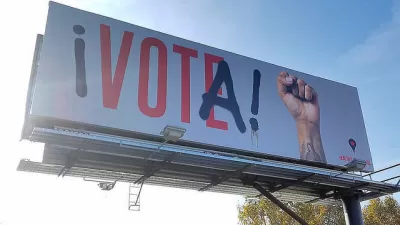I missed the APA national conference for the first time in 15 years -- but I quickly heard reports that one of the hot topics focused on banning electronic message boards. I dissent. What would Times Square be without the colorful, multi-message, oft-changing signs? Would Las Vegas have become the tourist definition that it has without the colorful signs? I am not a huge fan of Las Vegas, but I certainly think it has the right to define itself as it wishes.
I missed the APA national conference for the first time in 15 years -- but I quickly heard reports that one of the hot topics focused on banning electronic message boards. I dissent.
What would Times Square be without the colorful, multi-message, oft-changing signs? Would Las Vegas have become the tourist definition that it has without the colorful signs? I am not a huge fan of Las Vegas, but I certainly think it has the right to define itself as it wishes.
I have spent a lot of time on this issue over the last several years. The evidence is mixed, but I am convinced that signs distract drivers from their primary task and that rapidly changing messages distract drivers more than static ones. Our local zoning board somehow granted a variance to allow the conversion of an ill-placed billboard with a frequently changing electronic board that I can see from my family room window, and I hate it (the good news for the community is that there was a massive protest at the next request for such a variance and the board seems to have decided to stop giving them).
Rapidly changing signs do not belong everywhere. I do not like to see them on busy sections of highway with complex traffic patterns. They bother me less along open stretches of road passing small communities, but that is an aesthetic judgment on my part. They certainly do not belong in neighborhoods (as the one near me is). But as we attempt to recapture the vitality of our downtowns, it is worth looking back at old photos to see the movie marquees with exposed bulbs and simulated motion from changing neon tubes. Those and other lively signs helped to establish the character of our downtowns. Electronic message boards are simply a new technology for accomplishing the same effect. Are they a potential traffic hazard downtown? Think about Times Square. The only people who drive through there fast are taxis, whose drivers are no doubt inured to the sights. Similarly, in a vital downtown area traffic speeds should be somewhere between slow and modest. Although traffic can move at a decent speed on the Las Vegas Strip, traffic light cycles there are measured in minutes, not seconds -- allowing strangers plenty of time to watch a message cycle.
But electronic message boards simply represent a particular technology. Have you ever watched someone changing the gas prices on a traditional pole sign? They either teeter on ladders or juggle long poles with grabbers on the end. Either alternative has significant risks for the employees involved -- and the results are often letters that are crooked or mis-spaced, resulting in a cluttered look. Why on earth would we oppose the replacement of this old, messy and labor-intensive technology with a modern tool?
There are four real issues with electronic message boards: 1) location -- they ought to be allowed only in downtown areas and auto-oriented commercial districts; 2) size -- I have written many ordinances limiting the size of such signs to anything ranging from 20 to 120 square feet -- such limits preclude fully electronic billboards but allow the neighborhood drug store or grocery to announce specials and allow gas stations to use the technology; 3) brightness -- most if not all of the new electronic signs can be set to dim at night, when the brightness can be particularly obtrusive -- local ordinances should require that; and 4) frequency of changes -- allowing a change once per minute allows time and temperature signs (without reference to content) but precludes the rapid changes of message that can be particularly distracting. The industry pushes for 6-second or 8-second intervals; although those seem better that full motion, I think studies in the long range will show that they are just as distracting as full motion signs.
We are planners. We are presumably good at analyzing complex problems. We should certainly be able to parse an issue as simple as an electronic sign and address the specific issues that it raises rather than banning the technology. Some communities may choose to ban these signs, just as some communities ban exposed neon or signs containing colors. That is their choice. As a profession, however, and as individual professionals, we ought to help our communities make informed, context-sensitive decisions about such complex subjects.

Planetizen Federal Action Tracker
A weekly monitor of how Trump’s orders and actions are impacting planners and planning in America.

Maui's Vacation Rental Debate Turns Ugly
Verbal attacks, misinformation campaigns and fistfights plague a high-stakes debate to convert thousands of vacation rentals into long-term housing.

San Francisco Suspends Traffic Calming Amidst Record Deaths
Citing “a challenging fiscal landscape,” the city will cease the program on the heels of 42 traffic deaths, including 24 pedestrians.

Defunct Pittsburgh Power Plant to Become Residential Tower
A decommissioned steam heat plant will be redeveloped into almost 100 affordable housing units.

Trump Prompts Restructuring of Transportation Research Board in “Unprecedented Overreach”
The TRB has eliminated more than half of its committees including those focused on climate, equity, and cities.

Amtrak Rolls Out New Orleans to Alabama “Mardi Gras” Train
The new service will operate morning and evening departures between Mobile and New Orleans.
Urban Design for Planners 1: Software Tools
This six-course series explores essential urban design concepts using open source software and equips planners with the tools they need to participate fully in the urban design process.
Planning for Universal Design
Learn the tools for implementing Universal Design in planning regulations.
Heyer Gruel & Associates PA
JM Goldson LLC
Custer County Colorado
City of Camden Redevelopment Agency
City of Astoria
Transportation Research & Education Center (TREC) at Portland State University
Jefferson Parish Government
Camden Redevelopment Agency
City of Claremont






























